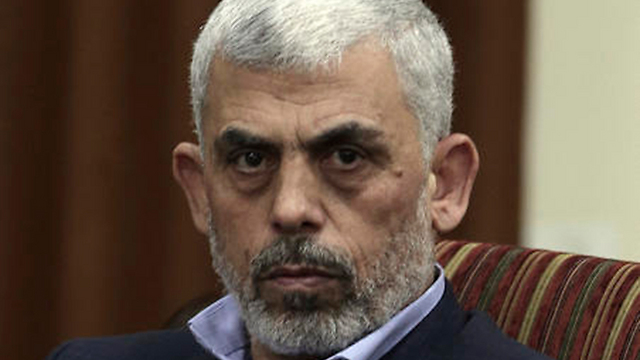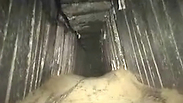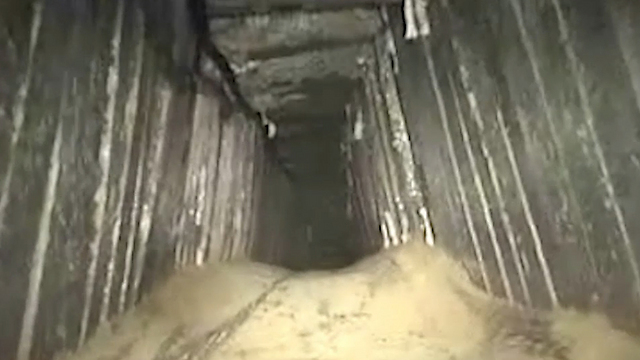
With tunnel under Gaza crossing, Hamas tried to deceive both Israel and Egypt
Analysis: The Egyptians who negotiated a reconciliation with the Palestinian organization likely never imagined that it would dare cooperate with ISIS and dig a tunnel reaching all the way to Sinai; the tunnel’s destruction by the IDF may now prompt Hamas and Islamic Jihad to initiate an escalation with Israel before losing all their underground assets.
For the past several months, since Israel uncovered two terror tunnels infiltrating its territory from Gaza, Hamas has likely avoided deciding how to react to Israel’s seizure of attack tunnels which it planned to use in the next escalation in the strip.
The tunnel underneath the Kerem Shalom border crossing was an operation of deception not only against the Egyptians, but against Israel too. Hamas likely believed the IDF would never imagine it was digging a tunnel under the strip’s only lifeline, endangering the population’s welfare.
Hamas’ military wing likely counted on this tunnel for smuggling strategic weapons, possibly heavy precision-guided missiles that would be sent to the strip from Iran through Sinai and serve Hamas in its next conflict with Israel. But that wasn’t its only purpose.
Another purpose was to infiltrate Israel and target the Gaza vicinity communities of Kerem Shalom and Shlomit, and possibly also bomb the crossing on its Israeli side, sort of like what Samson did when he said “Let me die with the Philistines,” a story Hamas apparently misinterpreted. The conclusion is that they were willing to sacrifice the Gazans’ welfare and vital needs in favor of a “strategic surprise” for Israel in the Kerem Shalom area.
Those who wondered about Hamas leader Yahya Sinwar’s apparent moderation have now received their answer. The restraint practiced by the radical terrorist, who was released in the Shalit deal, was simply a way of covering up his intention to carry out a murderous attack in Israel and bypass the Egyptian measures aimed at disconnecting the Islamic State in Sinai from Hamas and other Palestinian terror organizations in Gaza.

The tunnel’s exposure will likely also make it clear to the Egyptians that Hamas tried to deceive them. As we know, there are more than 1,000 smuggling tunnels on the Gaza-Sinai border, underneath the Philadelphi Route. These tunnels are mostly used for smuggling goods, but also for smuggling weapons and people from the strip to Sinai and from Sinai to the strip. Since these smugglings served the ISIS branch in Sinai, the Egyptians took different measures to disconnect the strip from Sinai.
These measures included destroying the tunnels and discharging sewage into them. Recently, the Egyptians dug a deep canal parallel to the Philadelphi Route and filled it with seawater, causing many of the tunnels to collapse. But the Egyptians likely never imagined that Hamas and other Palestinian organizations would dare dig a tunnel under Israeli territory which would reach Sinai.
A pretend reconciliation
The Egyptian intelligence official who negotiated a reconciliation with Hamas were willing to ignore the fact that Hamas and Egypt's Muslim Brotherhood movement are in fact the same thing under a different name. Egyptian President Abdel Fattah al-Sisi sees the Muslim Brotherhood movement in his country as an existential threat, but he was willing to reconcile with Hamas to prevent Palestinian aid from Gaza to ISIS, which is fighting the Egyptian army in Sinai and carrying deadly terror attacks.
In its distress, Hamas pretended to want the reconciliation and was willing to accept the Egyptian demands. The organization is receiving no aid from Arab countries or from Europe, and its relations with Iran have yet to yield the desired fruit. Seeing the economic, social and existential distress of the strip’s residents grow on a daily basis, Hamas’ new leadership in Gaza accepted all the Egyptian demands and even pretended to sever its ties with ISIS in Sinai.
Now, the Egyptians are discovering that Hamas actually deceived them. While making promises, it opened an underground bypass route to Sinai and to ISIS. Hamas likely did it to be able to smuggle strategic weapons from Iran through the Red Sea and Sinai, but the Egyptians understand the organization to receive ISIS’s approval to do that. Following the exposure of the tunnel on Saturday night, the Egyptians will likely draw their own conclusions about Hamas, which allegedly became their ally in the war on ISIS.
We must not forget the Israeli point too: On its way to Sinai, Hamas also prepared a strategic attack in Israel, cynically ignoring the fact that Israel could respond by cutting off the Gaza Strip’s only lifeline to the outer world, as the Egyptians have yet to open the Rafah Crossing for regular passage of goods and people. Israel is the only one allowing the passage of goods, fuel and gas to the strip’s residents and allowing people to cross into Gaza through the Erez Crossing.
Israel’s warning to Hamas
The IDF destroyed the tunnel on Saturday night and Sunday morning in a sophisticated manner aimed at preventing an escalation. It’s also possible that the army didn’t want to disrupt Prime Minister Benjamin Netanyahu's visit to India (https://www.ynetnews.com/articles/0,7340,L-5070257,00.html).
On Saturday night, the IDF issued a statement that the Kerem Shalom Crossing would be closed on Sunday, without providing further details. The statement was in fact a warning to Hamas shortly before IAF planes attacked the tunnel shaft in the Palestinian Rafah area.
The reason for the warning was to prevent casualties on the Palestinian side. Had Hamas people been killed inside the bombed tunnel, we would be in the middle of an escalation by now. The odd statement about the Kerem Shalom Crossing was also aimed at pointing out, both to sources in the strip and to international sources, that Hamas was jeopardizing the only lifeline from the strip for its military wing’s terroristic-operational needs.
The purpose of the warning was also to prevent harming uninvolved citizens in case of an unexpected accident during the tunnel’s destruction. Everything went as planned, however. The Air Force planes used particularly accurate and heavy ammunition to destroy the tunnel shaft on the Palestinian side, while other IDF forces—mainly engineering and infantry units—quietly destroyed the route of the tunnel on Israeli territory.
Hamas and Islamic Jihad now understand, without a doubt, that they are about to lose all their underground assets. Furthermore, the Egyptians are going to reevaluate their relationship with Hamas in Gaza. As a result, the probability that the two largest terror organizations in the strip will initiate an escalation with Israel, before losing the ability to surprise us with a strategic attack, is growing.




















